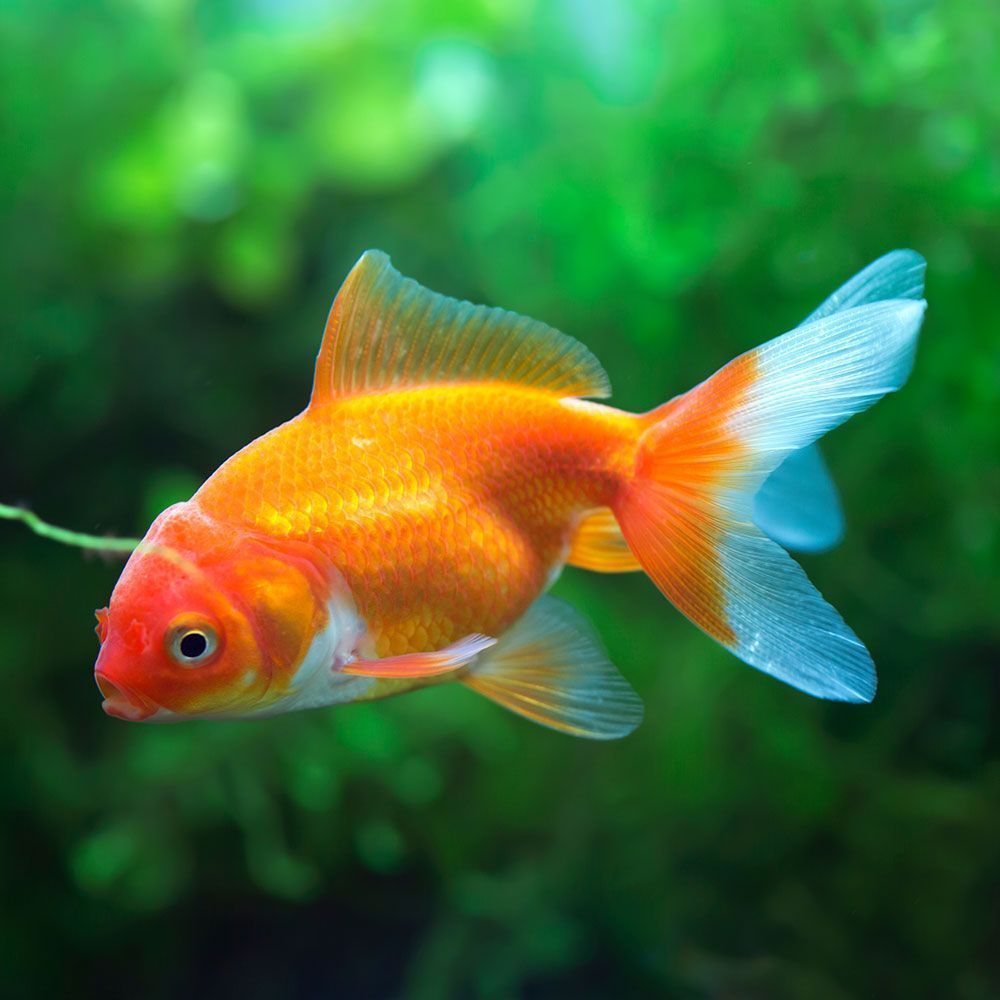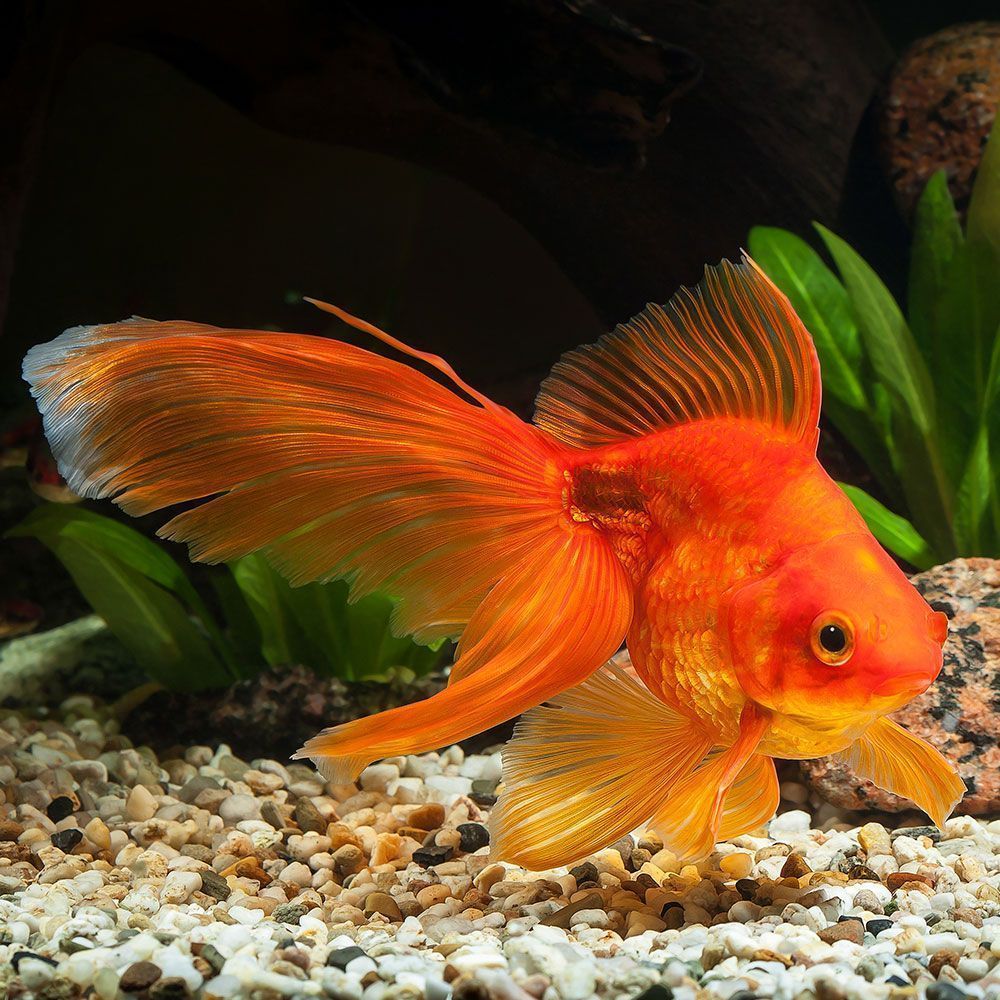If you are looking for an elegant-looking, easy-to-care goldfish for your freshwater tank, you should consider adding fantail goldfish.
Beloved for its graceful fins and beauty, this fish is excellent for both beginners and experienced aquarists. The fish is also generally low-maintenance, peaceful, and easy to feed.
Intrigued to know more, let’s dive into their fascinating world.
What is Fantail Goldfish?
Fantail goldfish is a freshwater fish that is famous for its double tail fins among the aquarium owners.
| Common Names | Fantail goldfish, double-tail goldfish |
| Appearance | Mostly orange, yellow, and red, egg-shaped body, speckled scales, double tail fins, arched dorsal fin |
| Size (Adult) | Usually 15-20 cm (6-8 in) in a tank, Up to 25-30 cm (10-12 in) in a pond |
| Lifespan | Typically 5 to 10 years, 15-20 years with great care |
| Temperament | Peaceful, non-aggressive, non-territorial |
| Tank Level | All levels |
| Care Level | Easy |
| Minimum Tank Size | 20 gallons for one fish, add 10 gallons per extra fish |
| Tank Mates | Own kind, other goldfish varieties of similar size and swimming speed, other peaceful species, larger invertebrates |
What is the History of Fantail Goldfish?
Fantail goldfish is a product of selective breeding by humans. It is distinctly different from the wild carp relatives. It belongs to the fancy goldfish category, created over many generations by breeding for specific traits.
How does Fantail Goldfish look?

Now, to gain a better understanding of how this species appears and behaves, let’s delve into more details.
What is the size of Fantail Goldfish?
The fantail goldfish typically measures between 15 to 20 cm (6 to 8 in) from nose to tail fin tip. However, the ones in ponds can grow even longer, sometimes reaching 25 to 30 cm (10 to 12 inches).
What is the color of Fantail Goldfish?
The most common shades of fantail goldfish include orange, yellow, and red. However, they also display a wide range of colors, including white, black, metallic blue, and calico patterns.
Some can be single-colored, while others are multicolored. High-quality ones feature balanced coloring and variegated fins.
What are the features of Fantail Goldfish?
The fantail goldfish has an egg-shaped, bulbous body, which makes it appear bloated. It has no shoulder hump and can have metallic or nacreous (speckled) scales.
Its double tail fins are unique, splitting into four lobes. The lobes form a triangle from above and a fan shape from the sides (which earns the fish its name).
The singular, tall, arched dorsal fin stretches to the tail base. It often has button eyes, though minor telescope eyes can develop at around 6 months but are rare.
It may exhibit traits from other fancy goldfish varieties, like a small head swelling or a tall body, depending on its breeding.
How do Fantail Goldfish behave?
The fantail goldfish is a peaceful and social creature. It explores and often groups up to swim together throughout the tank.
The species is constantly on the move and is often found playing around. This goldfish may nibble on aquatic plants or search for food.
What is the Lifespan of Fantail Goldfish?
Fantail goldfish typically live for about 5 to 10 years. In my experience, with optimal care, some can even reach 15-20 years.
How to take care of Fantail Goldfish?
Breeding and maintaining a fantail goldfish is quite similar to common goldfish. In this overview, we’ll focus on specific details about this species. However, we recommend you refer to the comprehensive goldfish care guide for a more thorough understanding before getting the fantail goldfish.
If you’re enthusiastic about getting this goldfish in your aquarium, let’s explore the correct care instructions to ensure its health and happiness!
What is the Tank Size for Fantail Goldfish?
To keep your fantail healthy, you’ll need a spacious rectangular tank, focusing more on length than height.
Invest in at least a 20-gallon tank for one fish and add 10 gallons for each additional goldfish.
The fish also thrives in outdoor garden ponds of 180 gallons or more. It produces a lot of waste, so larger tanks or ponds help maintain water quality and keep it happy.
What do Fantail Goldfish eat?
The fantail goldfish is omnivorous and enjoys both plant and animal matters. It’s not picky about food and seems like it’s continuously hungry. But you should pay attention to its diet as it has a delicate digestive system. Thus, it can’t break down various types of food easily.
The following kind of food works for them:
- Pellets
- Bloodworms
- Tubifex worms
- Daphnia
- Mosquito larvae
- Brine shrimp
- Zucchini
- Romaine lettuce
- Carrots
- Spinach
- Blanched peas
Select the right pellet size for your fish, with around 32-35% protein content and a 4-5% fat content. Choose sinking diets to avoid buoyancy disorders in your fish caused by gulping air at the surface while eating.
Adjust the feeding frequency based on the tank’s temperature:
- Below 70 °F (21 °C), feed once a day
- At or above 70 °F (21 °C), feed twice a day
Feed for about 2 minutes, ensuring there is no uneaten food left in the aquarium. Remember that moderation and a balanced diet are vital for their health and digestion.
Feeding Tip: Avoid fasting fantail goldfish, as it can shrink its stomach. When it eats again, the stomach rapidly expands, leading to stress on its swim bladder and other potential disorders.
Which Tank Mates are recommended for Fantail Goldfish?
Fantail goldfish are social creatures and should be kept in pairs or large groups for their well-being and to avoid loneliness and lethargy.
Stick to other fancy goldfish for best compatibility, as they share similar traits and don’t even mind sharing food. Potential tank mates include:
- Ryukins
- Celestial eye goldfish
- Bubble eye goldfish
- Black moor goldfish
- Oranda goldfish
- Lionhead goldfish
- Pearlscale goldfish
- Telescope eyes goldfish
You can also house them invertebrates like:
- Amano shrimps
- Large mystery snails
- Large apple snails
There are some non-goldfish tank mates for fantails. But, most species can’t be sustained in a tank full of goldfish due to their higher bioload.
You can still keep them with other peaceful species only if you can stay alert and ensure a clean environment. Some suggestions are the following:
- Rosy barbs
- Platies
- White cloud minnows
Which Tank Mates to Avoid for Fantail Goldfish?
Avoid housing the following together:
- Aggressive fish: They might bully these peace-loving species who are not equipped to defend themselves.
- Fast-moving fish: They may stress these relatively slow-swimming species.
- Fast-swimming goldfish varieties (ranchu goldfish): They’ll outcompete these during feeding.
- Smaller fish or invertebrates (smaller snails, cherry, and ghost shrimps): They could be mistaken for food.
Specifically, keep your goldfish away from the following species:
- Bettas
- Oscars
- Cichlids
- Tropical fish
- Livebearers
- Tetras
- Danios
- Corydoras
- Loaches
- Kois
- Marine species
What are the Common Diseases for Fantail Goldfish?
Fantail goldfish are known for their hardiness and can endure many common mistakes beginners make. However, their unique body shape limits organ space, making them susceptible to disorders like swim bladder diseases.
They can also suffer from fin rot owing to their delicate, flowing fins. The detailed causes, symptoms, and treatment for these ailments are given in the comprehensive article on common goldfish. Please check the same for a clear understanding.
Quick Tip: Quarantine new fantail goldfish for several weeks before adding it to your tank. Treat it with external medication. To prevent diseases, deworm it every three months if it lives in a pond, and every two months, feed live foods and larvae.
A word from FishInAquarium
We hope you found this article on fantail goldfish insightful and informative. Their stunning colors, majestic tail fins, and graceful swimming style make them a popular choice worldwide.
If you carefully understand their needs and follow all the given guidelines, you will be able to enjoy a rewarding experience caring for these species.
Finally, if you had fun reading this article, we encourage you to share it with fellow aquarium enthusiasts.
Or, drop us an email if you have any questions, and our team members will be happy to assist you.


